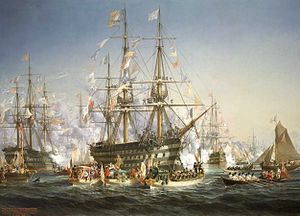 The Bretagne, painting by Jules Achille Noël, National Maritime Museum, London.
| |
| History | |
|---|---|
| Builder | Brest arsenal |
| Laid down | January 1853 |
| Launched | 17 February 1855 |
| Commissioned | 1855 |
| Decommissioned | 1865 |
| In service | 1855 |
| Stricken | 1880 |
| Fate | Scrapped 1880 |
| General characteristics | |
| Displacement | 5,289 tonnes, 6,875 tonnes full charge |
| Length | 81 m (266 ft) (at the water line) |
| Beam | 18.08 m (59.3 ft) |
| Draught | 8.56 m (28.1 ft) |
| Propulsion | Indret steam engine, 8 boilers, 4,800 shp, 1 propeller |
| Speed | 12.6 knots (23.3 km/h; 14.5 mph) |
| Boats & landing craft carried | 1 × 13 metre boat, 1 × 11.5 metre boat, 4 × 10.5 metre boats, 1 × 8 metre boat, 4 × whaleboat, 2 × dinghies |
| Capacity | up to 1,800 passengers |
| Complement | 1,170 men |
| Armament |
|
| Armour | timber |
The Bretagne was a fast 130-gun three-deck ship of the French Navy, designed by engineer Jules Marielle. Built as a new capital ship meant to improve on the very successful Océan class, while avoiding the weaknesses found on Valmy, she retained most of the Océan's design, and incorporated the philosophy of "fast ship of the line" pioneered by Napoléon, with a rounded stern and a two-cylinder, 8-boiler steam engine allowing her a speed of 13.5 knots. The propeller could be retracted to streamline the hull when sailing under sail only.
Launched in 1855, she was too late to take part in the Crimean War. She was decommissioned in 1865, becoming a schoolship for boys and sailors in Brest. Struck from the Navy lists in 1880, she was broken up that year.